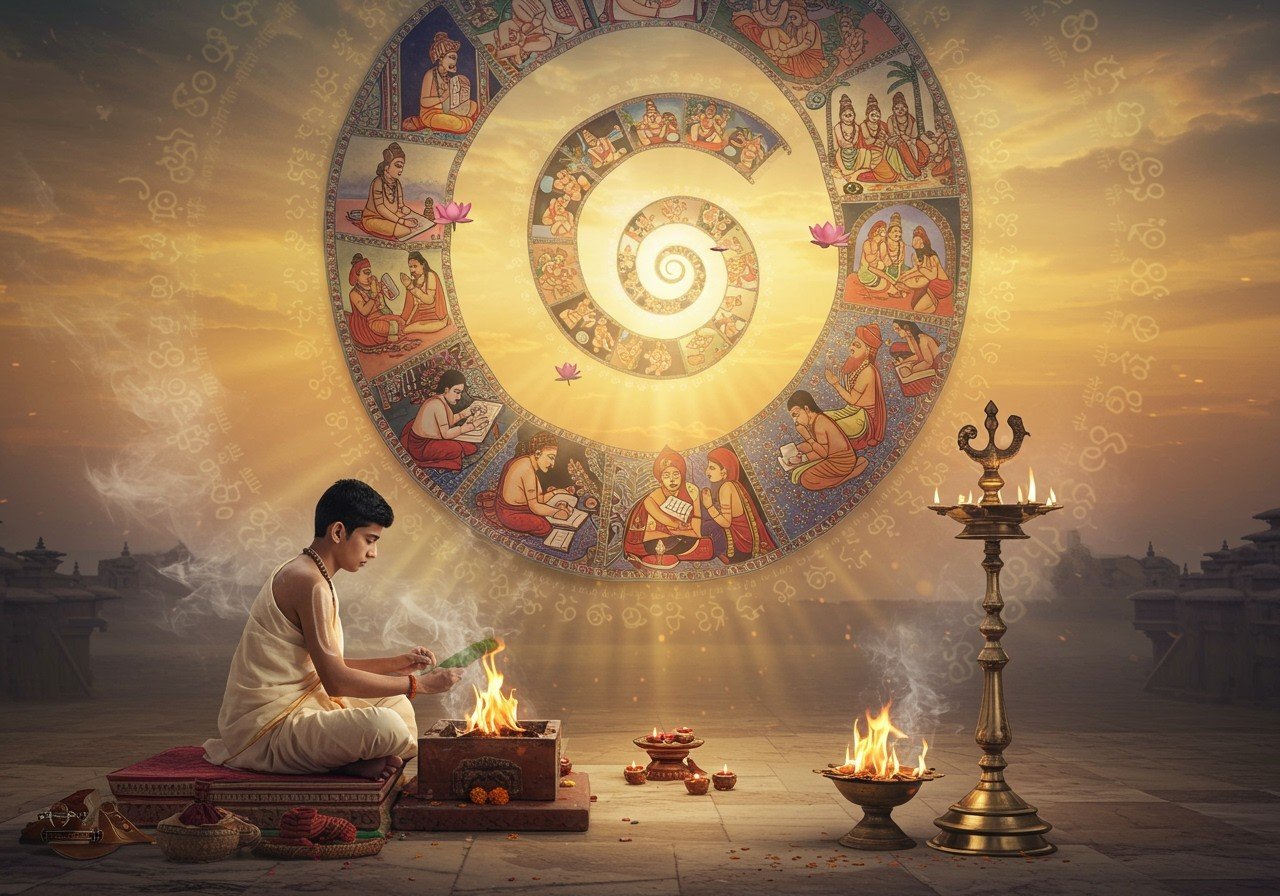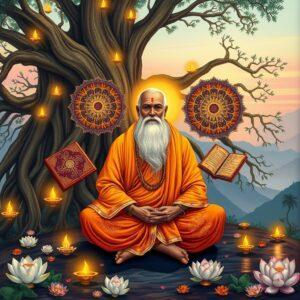
The Vedic influence on Hinduism is a topic of deep cultural significance, especially for Indians. The Vedic period, renowned for its ancient scriptures and rituals, laid the groundwork for Hinduism as it exists today. This article delves into the origins, evolution, and enduring relevance of Vedic practices in contemporary Hinduism. By understanding these influences, we can appreciate the continuity and change that have shaped Hinduism over millennia.
Vedic Origins of Hinduism
The Vedic period, spanning from around 1500 BCE to the 6th century BCE, is considered the bedrock of Hinduism. The Vedas, the oldest sacred texts, comprise the Rigveda, Samaveda, Yajurveda, and Atharvaveda. These texts, composed in Sanskrit, contain hymns, rituals, and philosophical teachings that have profoundly influenced Hinduism.
- Social Structure: Vedic society was structured around four Varnas (classes): Brahmins (priests and scholars), Kshatriyas (warriors and rulers), Vaishyas (merchants and farmers), and Shudras (laborers and service providers). This social hierarchy played a significant role in shaping the societal norms of the time. This system, while initially flexible, later evolved into a more rigid caste system. The concept of Dharma, or duty, was closely tied to one’s Varna, outlining the ethical and moral responsibilities associated with each class.
- Key Deities: Central to Vedic worship were deities like Agni (fire god), Indra (king of gods), Surya (sun god), and Soma (a sacred drink). These deities represented natural forces and played important roles in Vedic rituals and ceremonies. The rituals often involved offerings and sacrifices to these deities, accompanied by the chanting of Vedic hymns.
- Dharma and Ashramas: The concept of Dharma, the moral and ethical duties, was first articulated in the Vedas. This concept became a cornerstone of Hindu philosophy and continues to guide moral conduct in modern Hinduism. The Ashram system outlined four stages of life: Brahmacharya (student), Grihastha (householder), Vanaprastha (forest dweller), and Sannyasa (renunciation). This system provided a framework for personal and spiritual development throughout life.
Evolution of Vedic Practices
Between the 6th and 2nd centuries BCE, the Vedic religion gradually transformed into what we know today as Hinduism. The Shruti scriptures, including the Vedas and Upanishads, became foundational texts. Vedic Hinduism, also known as ancient Hinduism, emphasized knowledge, learning, and sacred hymns. This period saw a shift from primarily ritualistic practices to more philosophical and introspective inquiries.
- Bhakti Movement: The rise of Bhakti (devotional) movements simplified rituals and emphasized personal devotion to deities. This movement made religious practices more accessible to a wider range of people, fostering a more personal connection with the divine.
- Temple Culture: The development of temple culture marked a significant shift from fire sacrifices to idol worship. Temples became centers of religious and social life, and the worship of deities through icons and images became a prominent feature of Hindu practice.
- Regional Influences: Incorporation of regional deities and practices enriched the ritualistic landscape. As Hinduism spread across different regions of India, it absorbed local traditions and beliefs, leading to a rich tapestry of diverse practices and interpretations. This cultural exchange contributed to the evolution of Hinduism into a multifaceted religion.
- Codification of Laws: The Smritis, including texts like Manusmriti, provided codified laws and guidelines for social conduct. These texts addressed various aspects of life, including marriage, inheritance, and social responsibilities, contributing to the development of a more structured social order.
- Interfaith Interactions: Influence from Buddhism and Jainism led to reinterpretation of Vedic concepts. The interaction with these other philosophical and religious traditions prompted a re-examination of Vedic ideas and contributed to the development of new philosophical perspectives within Hinduism.
Similarities and Differences
While there are continuities between Vedic and modern Hindu practices, significant differences also exist.
- Continuity in Rituals and Dharma: The continued use of Vedic chants and mantras in temple rituals and ceremonies demonstrates the enduring legacy of Vedic traditions. Both Vedic and modern Hindu practices emphasize the importance of Dharma, although its interpretation has evolved over time.
- Evolution of Deities and Rituals: Modern Hinduism includes a wider pantheon of deities compared to the Vedic period. Vedic rituals were predominantly fire-based; modern rituals often involve idol worship, offerings of flowers, food, and other items, and elaborate temple ceremonies.
- Transformation of Caste System: While the caste system originated in the Vedic period, it has undergone significant transformations in modern times. Social reforms and legal measures have challenged the rigidity of the caste system, promoting greater equality and social mobility.
Continuity in Vedic Influence
Despite changes, core principles of Vedic traditions continue to resonate in modern Hinduism.
- Reverence for Vedas and Yoga: The Vedas are still revered as sacred texts among Hindus, and Vedic chanting remains an integral part of many ceremonies. The practice of Yoga, rooted in Vedic traditions, has gained global popularity, highlighting the enduring relevance of these ancient practices.
- Festivals and Yajna: The celebration of festivals like Diwali and Holi showcases continuity with Vedic traditions, although the interpretations and celebrations have evolved. The concept of Yajna (sacrifice), while less common in its original form, still plays a role in various Hindu ceremonies, often symbolized by offerings of food and other items.
- Pilgrimage and Sanskrit: The importance of pilgrimage to sacred sites persists, reflecting the Vedic emphasis on sacred geography. The use of Sanskrit in prayers and hymns maintains the linguistic heritage and connects modern Hindus to their ancient roots.
Regional Variations
The Vedic influence on Hinduism varies across different regions of India due to cultural diversity.
- Architectural and Ritualistic Adaptations: South Indian temples often incorporate Dravidian architectural styles alongside Vedic rituals, demonstrating the integration of local traditions with Vedic practices. Similarly, North Indian temples often feature influences from Mughal architecture, showcasing the syncretic nature of Hindu temple architecture.
- Regional Religious Practices: East India blends Shakta worship with Vedic and Tantric practices, creating a unique regional expression of Hinduism. Western Indian states emphasize Vaishnavism with roots in Vishnu worship, while Himalayan regions integrate local deities with Vedic practices, showcasing the adaptability of Hinduism to diverse cultural contexts.
How Poojn.in Supports Your Vedic Practices
Poojn.in, India’s leading online store for cultural goods and services, offers a wide range of products to support your Vedic practices. We understand the importance of authenticity and quality in Vedic rituals. Explore our collection today at www.poojn.in.
- Ritual Items: Find pure copper and brass items for havan and yagya rituals, crafted according to Vedic specifications. We also offer traditional bell metal utensils for sacred ceremonies, ensuring the purity and authenticity required for Vedic practices. You can find Bel malas, Tulsi malas, and other items essential for Vedic rituals.
- Sacred Texts and Incense: Explore authentic Vedic texts and prayer books in Sanskrit with translations to deepen your understanding of Vedic traditions. Enhance your ceremonies with natural incense and dhoop following ancient Vedic formulations, creating a sacred atmosphere for your rituals.
Conclusion
Hinduism’s journey from its Vedic roots to its present form reflects its adaptability and enduring relevance. The Vedic traditions have profoundly influenced Hindu life, from rituals and worship to social conduct and philosophy. While modern Hinduism has evolved, the core principles of the Vedas continue to enrich the spiritual lives of millions. As we honor these ancient traditions, we also embrace the changes that make Hinduism a vibrant and dynamic faith. The continuity and change within Hinduism speak to its enduring relevance and deep respect for its sacred heritage.


